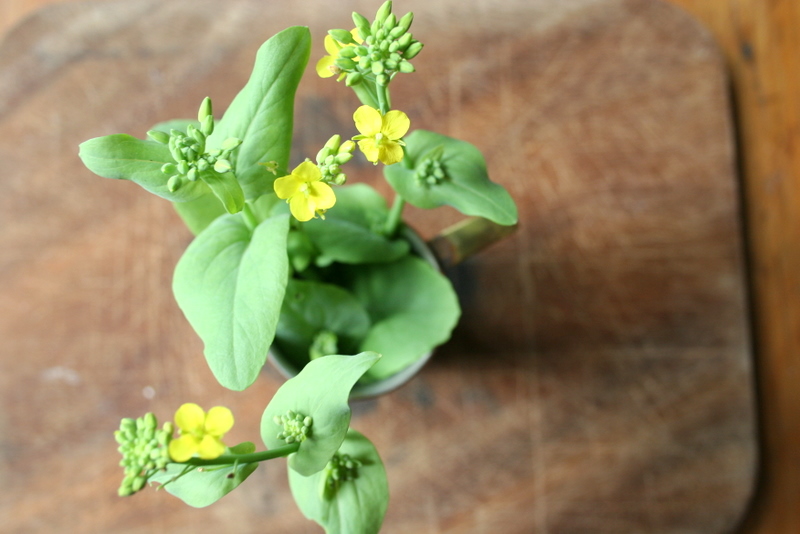Well, after complaining about the weather for the entire month of June, I'm here to complain about all the warmth and sunshine we've had so far in July. Kidding, kidding! The last week has been nothing short of glorious. My tomatoes are stretching toward the sun, my broad beans are blooming like crazy, and my snow peas are scrambling over one another to climb their repurposed-wicker-bookshelf trellis. The sudden heat has had one adverse effect, though. I have bolting brassicas!
"Bolting" is the term for what happens when a leafy plant - cabbage, lettuce, spinach, that kind of thing - suddenly throws up a long flower spike and blooms. It can happen so quickly that you don't notice until it's too late: you water your little cabbages in the morning, then, by afternoon, you don't recognize them any more. The leaves change shape completely, and instead of a tight rosette on the ground, you have a tall, stalky thing with four-petaled flowers, looking rather weedy and unwelcome.
It's interesting, I'll grant you that, but unfortunately it makes the plant quite unpalatable. The leaves turn tough and bitter, and all the plant's energy goes into producing a flower and, in turn, seeds. It's kind of a last-ditch effort at domination for the plant. It senses that the end is nigh, and tries its best to reproduce before it's too late.
Premature bolting is brought on by some kind of stress, usually a rapid shift in temperature (ahem), but also by drought, cramped conditions, and general plant unhappiness.
The first to bolt were my Chinese cabbages. I'll admit, I didn't have much of an investment in them from the start. I had ordered them as transplants from The Organic Farm in Portugal Cove, just as a late-night online-shopping afterthought. When I got them, they were already quite large for their little pots and should have been transplanted right away, but I didn't know where I wanted to put them, and beside, it was raining and mucky ouside. So I let them sit. And sit. And sit. When I finally found a spot for them, their roots were all cramped and the older leaves were yellowing. It's no wonder they shot to flower the second the sun came out, poor miserable things.
I'm much sadder about the loss of my rapini (also known as broccoli raab, or broccoli rabe), which I have been growing from seed in my back yard. I love rapini, and can hardly ever find it here. It's a cool-weather crop, so it is supposed to do well in the spring and the fall. Mine had been coming in gorgeously, but, again, as soon as it got warm they shot up and are now about to go into flower. Instead of thumb-thick stalks with tight florets, I have lanky greenery with small bundles of buds.
All is not lost, of course. The Chinese cabbage flowers can go into a salad, so at least I get to eat some part of them. And the rapini can come out of the ground now before it flowers and get cooked as greens for supper tonight; rapini is closely related to the turnip greens I love so much, and so I'll eat the leaves and stalks the same way. Next year, I'll plant my rapini and cabbages in a shadier section of the yard, where they'll have a little shelter once summer heat hits. I think I'll sow more rapini seeds in the fall, too, and hope the long, slow march to winter suits them better than our late-but-rapid-onset summers.
And that, my friends, is all the complaining you'll hear out of me. Summer is here, and I couldn't be happier!
(PS You can always read more about my gardening adventures, and see lots of photos, on my blog. Come on over!)











